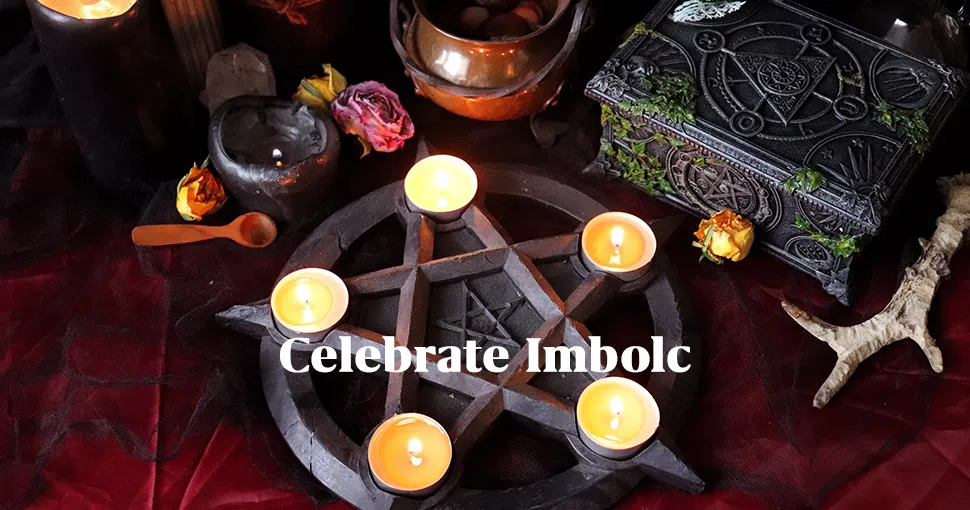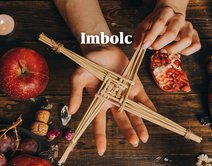In the bleak wintertime, new hope arrives around the first of February. The buds have begun to swell on the trees, birdsong pierces the deafening silence of the cold still air, and the light is stronger. Yes, these first signs of spring herald a new day when there is hope for climbing out of the hard freeze that has trapped the earth. Today’s people see this just as our ancestors have. It doesn’t take psychic people to see this is a great time of spiritual healing, a time to use your tools of the future to do divination, and perhaps most importantly, a time of bringing positivity into your life. This time has been traditionally celebrated as Imbolc to honor the goddess Brigid by pagans and as St. Brigid’s Day to honor her form as a Catholic Saint. This article will discuss:
- What is Imbolc?
- St Brigid’s Day
- Who is Brigid?
- What Does Imbolc Mean Spiritually?
- How to Celebrate Imbolc
The word “Imbolc” might not be one you have heard before, and indeed, it’s one of antiquity. The word means “In the belly”, and alludes to the fact spring is beginning slowly, and life is “in the belly” of the earth, ready to burst forth soon! It also refers to sheep that are pregnant with their ewes and are thus producing milk. What is the day, and what does it celebrate? What is the spiritual meaning of it, and how can you channel the sacredness of this day to bring positive energy into your life?
What is Imbolc?

Imbolc, an ancient holiday, has been celebrated between the Winter Solstice and the Spring Equinox since Pre-Christian times. It is one of four Gaelic Irish high days, or holidays which also include Beltaine on May 1, Lughnassadh on August 1, and Samhain on November 1. Imbolc celebrates the beginning of Spring and it corresponds with when the sheep are pregnant with ewes, and are producing plenty of milk. Imbolc is well known to be an Irish holiday, but it has not just been celebrated in Ireland, but has been historically celebrated in Scotland and the Isle of Man also, and in modern times, it is celebrated around the world, sometimes in the form of a Catholic offspring of the high day that is called St. Brigid’s Day. Traditionally, overthrow of winter was celebrated as the time when a spring and summer goddess named Brigid seizes power from the winter “hag” also known as the goddess Cailleach. Some believe these two goddesses are forms of one another, and at Imbolc, the Cailleach transforms into Brigid, and at the onset of winter, Brigid transforms back into the Cailleach.
At Imbolc, veneration of the goddess is done with prayers, and by leaving clothing outside for her to bless. A bed is set up for Brigid, welcoming her into the home, and people ritually washed their hands, feet, and head for purification to wash away the malevolence of the harsh winter, and spring cleaning of the home to sweep away all bad spirits was done. Dairy is abundant because of the sheep having ewes so there is feasting, and preparation for spring sowing as well as blessing of the seeds and farming tools are done. It is believed that it is a good time for divination, and visits to healing wells were made. Offerings are left at the wells, some of which are hung on blessed trees, and water from the wells is used to bless people, the animals, the home, and the land.
Weather divination is done to see how soon warmer spring weather can be expected, and sometimes in the past, the celebration was not held on exactly February 1, but whenever it was deemed most appropriate based on what the weather was doing. Some would insist it needs held on the Full moon closest to February 1, and others simplify and just celebrate every February 1. Some people don’t believe that Brigid is a goddess, however, but venerate her as an early Catholic Saint whose devotion to her religion was unbreakable. Others believe that the reuse of the name Brigid was a cultural thing, it being a common name for girls, and others feel the Catholic Church created a myth of a Saint for people to venerate to make it easier to convert them away from paganism to Christianity.
St Brigid’s Day

St. Brigid of Kildare’s Feast Day is celebrated February 1 by Roman Catholics. They believe there is no goddess like the pre-Christians did, but that Brigid is a Saint they admire and honor. She is honored at Mass with prayers and songs like any other Mass, and some Catholics have carried over some pre-Christian practices at home, making a bed for St. Brigid, and inviting her into the home. In the Americas, most Catholics won’t do the cultural British veneration, but will instead celebrate her at church. St. Brigid Catholic Church has an online listing of readings for the Mass, and the first reading is as follows:
The First Reading is from Sirach 2:7-11
“A reading from the book of Sirach.
You who fear the Lord, wait for his mercy; turn not away lest you fall.
You who fear the Lord, trust in him, and your reward will not be lost.
You who fear the Lord, hope for good things, for lasting joy and mercy.
You who fear the Lord, love him and your hearts will be enlightened.
Study the generations long past and understand: has anyone hoped in the Lord and been disappointed?
Has anyone persevered in his commandments and been forsaken? Has anyone called upon him and been rebuffed?
Compassionate and merciful is the Lord: he forgives sins, he saves in time of trouble and he is a protector to all who seek him in truth.”
Who is Brigid?
For a Goddess and Saint to be so venerated for so many generations tells us she was very special and very well loved, but who is she? What is Brigid the goddess of, and who was this St. Brigid the Catholics still celebrate?
The Goddess Brigid

The Goddess Brigid was born the daughter of the Dagda, or “The great god” and both she and her father were of the legendary Tuatha De Danann, or “ the folk of the goddess Danu” of the tribe of the gods. It was believed they represented the most ancient of Irish gods and goddesses and they were royalty and great heroes. Brigid’s name means “exalted one” and she is the goddess of poets and bards, healing , wisdom, protection, domesticated animals, and blacksmithing. A holy well at Kildare and an eternal flame was maintained for her in pre-Christian times, and the Catholics took over and are still maintaining both as veneration for their Saint.
Interestingly, the flame was kept alight for longer than we know, and it is accepted by scholars that pagan priestesses lit the flame on Kildare Hill in Ireland to pray for healing and the protection of the goddess Brigid. It was St. Brigid who took it upon herself to organize continuation of keeping the flame alight and she and nineteen other nuns took turns, with St. Brigid herself keeping it going on the twentieth day. The Flame burned until the suppression of the Monasteries in the sixteenth Century and was relit at a new site in 1993 from a flame lit at the earlier site and still burns to this day from a specially made sculpture that was created to protect it.
The Well is situated where Brigid’s monastery used to be and it has been made over with modern landscaping of course, but the truth is there are close to three thousand holy wells in Ireland, and at least fifteen of them are for Brigid! The one recommended is perhaps the very oldest and the one used in pagan rituals. It is located between the cliffs of Moher and Liscannor, and you can hear running water there. It is in a grotto and serves as an entryway to an old cemetery. It can be reached by very old stairs and steep pathways.
The goddess not only protected domestic animals, but she also watched over women while they were giving birth and she was a deity of hearth and home. She was a triple goddess, with two sisters who were also named Brigid, and it has been said that perhaps “Brigid” was more of a name that meant “goddess” than just the name of one triple goddess. The goddess of real healers, people with psychic abilities, women, domestic animals, smithing, and the bardic and poetic arts, Brigid is the blessed one who comes forth in spring to make the earth green again with her great power. She is welcomed and revered by many, even Christians who have made her into a Saint. Before Brigid comes, another goddess, who may be an aspect of Brigid is present, and that is the Cailleach.
The Cailleach

The story goes that in winter, the Cailleach, also known as Beira, takes control of the land to make it her domain. The name Ceilleach means “veiled one”, and Beira comes from the spelling Bheara which means “sharp” or “shrill”. It is believed she is a creatrix who not only created parts of the landscapes, but she is considered to be the mother of all the gods and goddesses. When she carried rocks in her baskets, she dropped some as she walked across the land. She left them there, and thus created some hills and mountains. Her mighty footsteps hollowed out parts of the earth to make valleys, and some filled with water to make lakes. It is she who makes winter spread across the earth.
One story says that she strikes the ground with her staff, bringing snow and ice, and another says she washes all the color out of her plaid garment in the Gulf, or Whirlpool of Corryvreckan every year. It is said that once the garment is pure white, she spreads it across the land and that is how she blankets the earth with snow.
She is watched every year around Imbolc to see what she will do. Around this time, thawing begins, and ice and snow will melt with the strengthening light. It is believed that the Cailleach and Brigid are battling for power, but Brigid will win. On into the warmer weeks that come, the Cailleach will throw surprise snow and ice storms and even huge hail and bitter winds to try and claim the earth once more, but Brigid always overpowers her. After spring turns to summer, summer turns to fall, and the days inch towards winter, the Cailleach appears, battling with Brigid until she overpowers her, making winter occur once more.
On Imbolc, it is said that if it is bright and sunny out, the Cailleach has caused the sun to shine so she can see to collect more firewood. Thus, the winter will last about six more weeks. What is desired is a cold, gloomy, yucky Imbolc day, because that will mean the Cailleach has overslept, and it will be too late once she wakes up to gather more wood on Imbolc, so spring is on the way! While some still watch the sky to see what the goddess will do, others look to the groundhog, doing weather divination based on whether he sees his shadow or not.
Some believe that the Cailleach and Brigid are the same goddess, and she changes from one form to the other based on what season it is. Others believe they are two separate goddesses, and what the earth does reflects their fights to rule. The Catholic Saint Brigid is quite another being, however.
Saint Brigid

St. Brigid of Kildare was born in either 451 or 452 in County Louth , Ireland. She is considered a Saint of learning, poetry, livestock, protection, healing, blacksmithing, and interestingly enough, dairy production. There is little besides legendary tales about her, and this along with the fact that what she is Saint of is what the goddess Brigid is goddess of leads many to believe that St. Brigid of Kildare was not a real person at all, but a way to help Christianize pagans.
Stories say that she was born to a mother who was a Christian slave, and a father who was a pagan chieftain. Said chieftain had a wife who was unhappy he had impregnated a slave, and the wife forced him to sell Brigid’s mother due to the pregnancy. She was sold to a Druid, who Brigid supposedly would not accept food from because she considered him impure, and a mystical cow instead fed her. This is yet another Imbolc image.
At age ten, she was returned by the Druid to her father, and he was quite aggravated by her because she gave his things away in the spirit of charity. She gave away entire supplies of butter to feed people, but it was always miraculously replenished when she prayed for it to be. Her father finally got tired of her giving his possessions away without his permission, and he loaded her up in a chariot to take her to the king to sell her. On the way, she gave away an especially valuable dagger that belonged to her father so a poor family could use it to barter for food. The legends say that the king was so impressed with Brigid’s generous spirit, he convinced her father to grant her freedom.
Perhaps Brigid could have stayed with the king since she had won his favor, and lived a rich life, but that was not what she wanted. Instead, she devoted her life to her god, becoming first a nun, then rising in ranks to be a mother abbess. As a holy leader, Saint Brigid founded her famous Monastery in Kildare where the priestesses tended an eternal flame for the goddess who shared a name with Saint Brigid. It is said that is near an oak tree in Westmeath. She went on to found monastic lines for women as well as men and opened multiple churches in Connacht.
There are legends about multiple miracles she performed, but perhaps the most famous story about Saint Brigid is the one about her cross. Interestingly, it has been accepted that the very cross attributed to her is the symbol of the goddess Brigid. The story says that Saint Brigid went to visit a pagan chief who was near death. As she visited, she picked up rushes and created her cross, and talked to him about her religion. Some say he was so impressed by the cross she made, that he converted to Christianity at that very moment. Other stories say people would make that cross and it would be gifted between enemies as a pledge of peace and it was used as a talisman for protection and to ward off malevolent spirits and energies when it is hung on a front door or above the doorway.
We may never know if this Saint Brigid was a real person, and history has combined her with the goddess Brigid, or if it is correct that the goddess was transformed into a Christian Saint whose life was dedicated to compassion and peace. We do know that both Christians and pagans celebrate February 1 in honor of Brigid, however, and the spiritual meaning of Imbolc will always be in the hearts of people no matter what their religion is.
What Does Imbolc Mean Spiritually?

Spiritually, Imbolc is about celebrating possibilities and being open to the intuitive meaning of hope. Like the earth is fertile, but life has not emerged yet we are filled with great potential, ourselves. It represents the hope that winter won’t last forever and watching the first signs of the budding life reminds us that in dark times when we, too, feel frozen like the earth is, we still have things inside of us that are bright and alive. Inviting the spirit of healing and purification after the darkness of winter, too is one thing Imbolc means, and embracing the feminine divine and all her protection is as well. Releasing things that have been bogging us down for winter as well as during dark nights of the soul is another meaning of Imbolc.
Some traditions empower men and phallic gods above all, but others venerate mother goddesses and female clergy persons as well. The undying devotion and love from women as creatrixes of life and those who nurture and empower can be accessed at Imbolc through the goddess Brigid and the Saint who bears her name and like the Saint and today’s Catholics continue the ancient pagan flame of the goddess Brigid, the power of tradition and spiritual community is felt during Imbolc.
How to Celebrate Imbolc

Maybe you are not a Catholic or a pagan, but the power of Imbolc speaks to you, and you want to celebrate it. There are a lot of different things you can do. You can participate in healing at Imbolc as well as use the energies of the high day for divination. You can also ask for blessings to bring the light of the holiday into yourself.
Healing
Are energy healers real? Natural healers of every type are real, and a simple way to celebrate Imbolc is to create a healing well of your own if you can’t make a pilgrimage to one. The way this is done is simple. Select some sort of cauldron, or bowl that is spiritually meaningful for you, and fill it with blessed water. If you have to, you can make it yourself by saying a prayer to the goddess that she may bless the water and charge it with her healing power. Water that has sat in the light of the Full Moon can also be used, and water that healing crystals like clear quartz and bloodstone have been submerged in can be used as blessed water also.
Lighting candles to surround the healing well and having everyone present say their prayers for healing before anointing themselves with the blessed water is good practice. Everybody can be given some of the water to take home with them to sprinkle around their homes for purification, and their family members, pets, houseplants, and gardens can benefit from being sprinkled with this blessed water as well.
One last healing question is “Can you heal somebody from a distance?” Psychic healers have healed people both in person and from afar many times, but it is important to ask if the individual would like healing first. After being given permission, stop and take the time to get psychic visions of the individual who you are healing with psychic energy work. Energy moves, and if you can send psychic power or energy, and the person you want to heal can receive it, sending the healing energy can be as simple as willing it to go out to them.
Get a Psychic Reading
Getting a spiritual reading during this time when divination is easier is a great way to celebrate Imbolc. The goddess of divination’s voice can be called upon if you like, or you can just have faith in the positive energy of the high day to open messages from the universe. Perhaps your psychic destiny is to be a reader who helps other people. You can pray to the goddess that she brings the people to you who need you and to guide you to give them the right answers just before Imbolc.
Getting a psychic reading online may be what you prefer, and in this day and age, you may be searching for a psychic reading online for free. We don’t give whole readings free, but we do give free minutes when you sign up with us. For your psychic reading free of charge, however, you can enroll in classes to learn to practice divination for yourself and signing up around Imbolc can be an incredible way to celebrate.
Another way of practicing divination is to seek self-knowledge and the goddess can help with this. As she is a goddess of wisdom, if you ask her to reveal to you what your greatest strengths you should build on are and what your weaknesses you need to work on are. Then listen! The answer from her might come as what sounds like a harsh criticism from somebody who does not like you, or something as peaceful as shapes in passing clouds, but she will always answer!
Ask for Blessings
Asking how to bring positive energy into your life at Imbolc with your intuitive soul is a wonderful way of how to connect to source energy from the earth and the goddess Brigid herself. Using your intuitive, meaning spiritual voice, pray that you receive the blessings the holiday offers. A prayer like this can be said:
“May the life within the earth, ready to burst forth enter me
And fill me with the passion to move forward.
May I reignite old dreams I dared not pursue
And leap joyously forward to begin to live them.
May all that is broken within me be healed.
May all the darkness in my soul be chased away with light.
May the Divine Mother, creatrix of all touch my soul
So that I, too may create worlds of wonder I never imagined could exist.
So Mote It Be.”
Imbolc has been observed for hundreds, and perhaps many thousands of years by people from many faith traditions. It is a time of healing for ourselves and others and of spiritual and physical purification. It is a time to prepare for new growth and new things because the dark times are ending, and forward movement is about to begin again. It is a time to welcome the power of mighty matriarchs of faith who influence and inspire us, and a time to celebrate because new abundance is at hand. However you celebrate Imbolc may Brigid bless all who are in your home whether they have feet, paws, hooves, wings, or fins. May the light and new growth of the season awaken parts of yourself you had lost touch with, and may you be healed, strengthened, and may your home be filled with joy and love and protection. So be it.
We have selected the most relevant psychics for this article, you can connect with any of them and get accurate advice on this subject.









